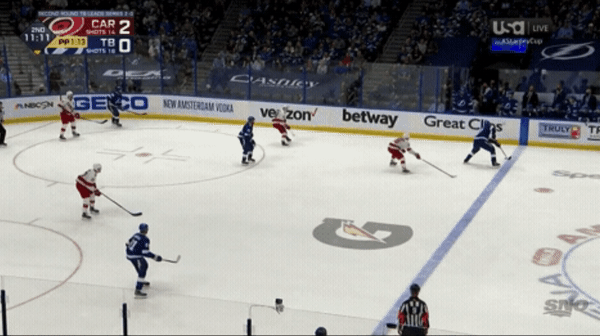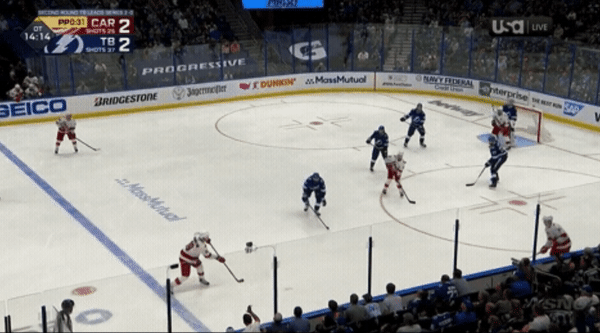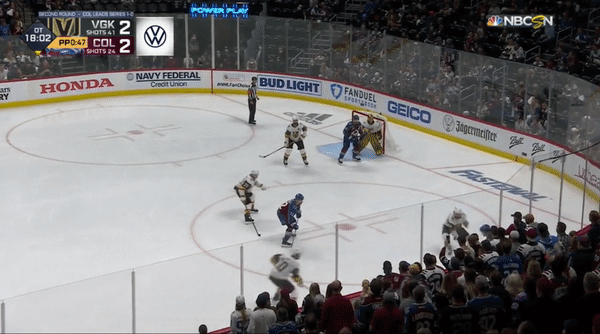Watching last Thursday night’s games, I was blown away by one very specific thing: just how ridiculous the talent and execution work is on the power plays of the league’s best teams. The Tampa Bay Lightning and Carolina Hurricanes were among a handful of Cup favourites this season, and it’s been easy to see why.
Last night to get on the board Tampa Bay’s power play did this:

That’s ridiculous player and puck movement, threading needles with passes which forces the D to move, then making themselves available in the seams that are opened up by that movement.
Tampa Bay would score another power-play goal to take that one to overtime, where the Canes would do this:

A nice play on the half-wall up to the point, which leads to the puck changing sides, Sebastian Aho popping up into the slot (how high he comes up is what makes it work), and getting a shot where they still have a presence at the net-front. It’s simple, but checks a lot of the basics for a good power play.
I’m of the belief that a good power play is increasingly important in having post-season success these days. Coaches continue to strangle the life out of 5-on-5 play the best they can. Referees are rendered helpless by players committing what appears to be double the borderline infractions at even strength each game, which clogs things up further. You just get so few openings in the normal run of play that it’s more crucial than ever to create when you’ve got a man advantage.
In general, a power play above 20 per cent will have you in the top half of the league in conversion rate, and below will have you in the bottom half. Below are the power play percentages (in the playoffs) of the teams who’ve made it into the Cup Final the past five years.
2020 Final: Tampa 22.7 per cent, Dallas 22.4 per cent
2019 Final: St. Louis 16.3 per cent, Boston 32.4 per cent
2018 Final: Washington 29.3 per cent, Vegas 18.5 per cent
2017 Final: Pittsburgh 20.5 per cent, Nashville 16.9 per cent
2016 Final: Pittsburgh 23.4 per cent, San Jose 24 per cent
That’s an average of 22.6 per cent for Cup Final teams the past five years, with the average the past three years being higher.
[snippet id=5039904]
You don’t have to have the best power play on earth to win the Cup — as St. Louis proved — but, in general, to go deep in the playoffs and get it done it helps an awful lot. It’s one of the reasons the Toronto Maple Leafs have found themselves on the outside after one round the past couple years, as they’ve posted percentages of 13 per cent (15th among playoff teams), 15.4 per cent (15th again), and 18.8 per cent (ninth) over the past three seasons.
This leads me to this season, where a few teams have been out of this world on the power play, and weird, also happen to be the Cup favourites.
Early in this post-season, the Boston Bruins are third best at a whopping 32 per cent. The aforementioned Lightning are at 39.3 per cent. This brings us to the Colorado Avalanche, who are currently converting at a 43.5 per cent clip on their power play through six playoff games. (That’s a little juiced thanks to two empty net PP goals, but it’s been amazing with those excluded, as you’ll see.)
You can’t bully a team who can do what they’ve done when up a man. Just look at the way they change places (you’ll see Nathan MacKinnon at the top in one clip and Cale Makar on the wall), move the puck quick, and just generally avoid stagnation. There’s no predictability with where the shot is coming from, with the added bonus that the players in the shooting positions can all hit one-timers.

Even with some regression back to their regular-season power play percentage of close to 23 per cent, it’s a huge strength for this team. Even when the movement isn’t flawless, their elite shooters find ways to get pucks through and in.
So that’s key number one for me on why the Avalanche look so unstoppable, but it’s impossible to miss how things are stacking up in their favour here. They’ve moved from “among the favourites” to the the clear, capitalized Favourite.
They’re up 2-0 in their second-round showdown with the team who narrowly missed out on their President’s Trophy, the Vegas Golden Knights. Some like to say that a playoff series doesn’t start until someone wins on the road, which is cute but outright wrong in the same way as “a two-goal lead is the worst lead in hockey.” I get the philosophical point being made, but no. It’s currently 2-0 for the best team over the 2020-21 season. The series has well begun, and I like their odds here.
Past this round (and we get to look there, because we aren’t players), it doesn’t hurt that in the North, the division champion Leafs were upset by the Montreal Canadiens and the second place team (Edmonton) was also upset. That means the winner of Avalanche-Golden Knights gets the three- or four-seed in what was arguably the league’s weakest division in the third round. Seeing how it’s going against Vegas, you have to like their odds there, too.
The case for the Avs not being clear front-runners is that the defending Stanley Cup champion Lightning are still alive and well, but the lead in their series is 2-1 not 2-0, and they’ll play the winner of Bruins-Islanders, meaning they have another formidable opponent to go through if they hope to reach the Cup Final.
[relatedlinks]
To just zoom out on the team, too, there’s all the Avs’ regular-season numbers — pick a metric (advanced or otherwise) and they were almost certainly at the top of the league. The gap between their shot attempt differential and the second-best team was about the size of the gap between the second-best team and the league’s 13th best, for context on how much they controlled the run of play.
At this point, MoneyPuck, which calculates a team’s odds of winning each game, round, and the Cup, has the Avalanche’s odds of winning the Cup at a staggering 44.3 per cent. The Bruins are given the next highest odds, which are less than half as good at 21.5 per cent.
Nothing is promised in the NHL, and there’s a cliché that gets said after upsets that’s relevant here: “That’s why the play the games.” So play the games they shall, but after 60-plus hockey games this season, the Avs are one of the most dominant teams of the past decade with hope in their series ahead, and a considerable underdog opponent next.
The plan to stop teams like that is usually to grease it up and drag them down into the muck, but it’s the first part of this article, that power play, that should nullify anyone’s ability to do that. If that group can keep clicking even half as well as they have in playoffs so far, the Avs are all but a lock to be playing for the Stanley Cup just a few weeks down the road.





COMMENTS
When submitting content, please abide by our submission guidelines, and avoid posting profanity, personal attacks or harassment. Should you violate our submissions guidelines, we reserve the right to remove your comments and block your account. Sportsnet reserves the right to close a story’s comment section at any time.